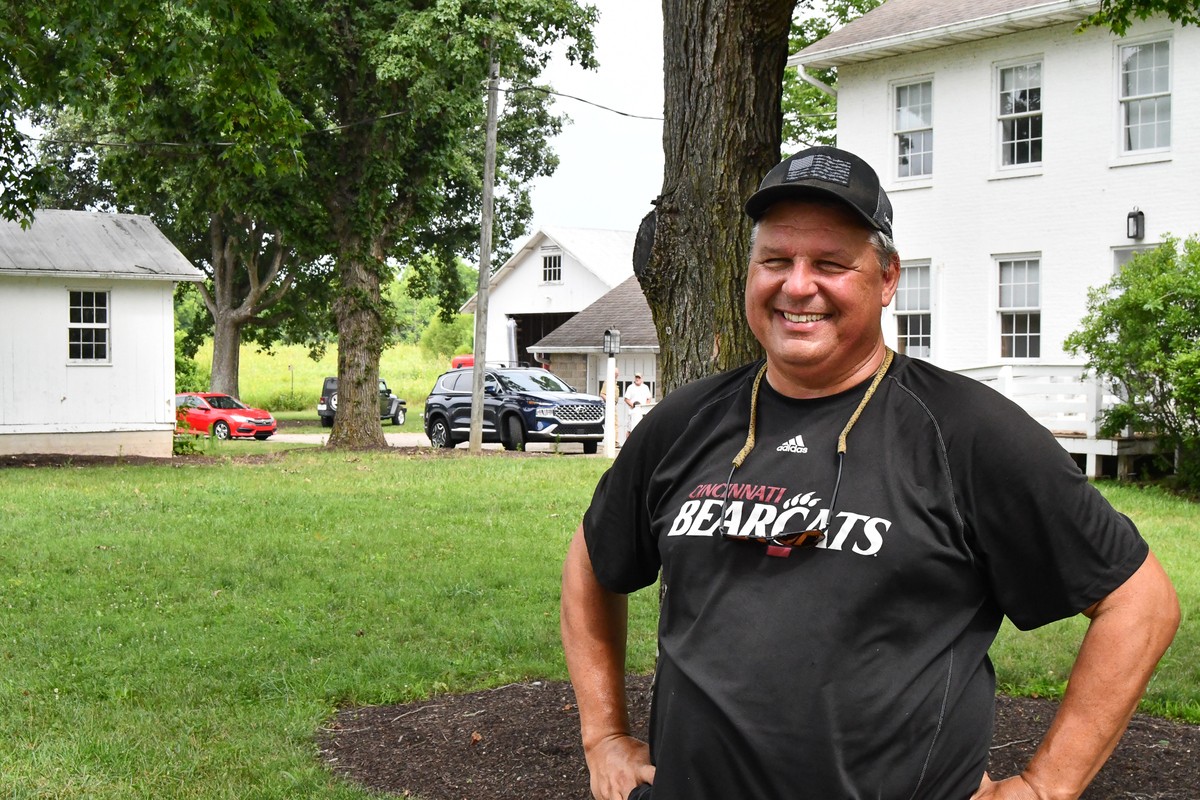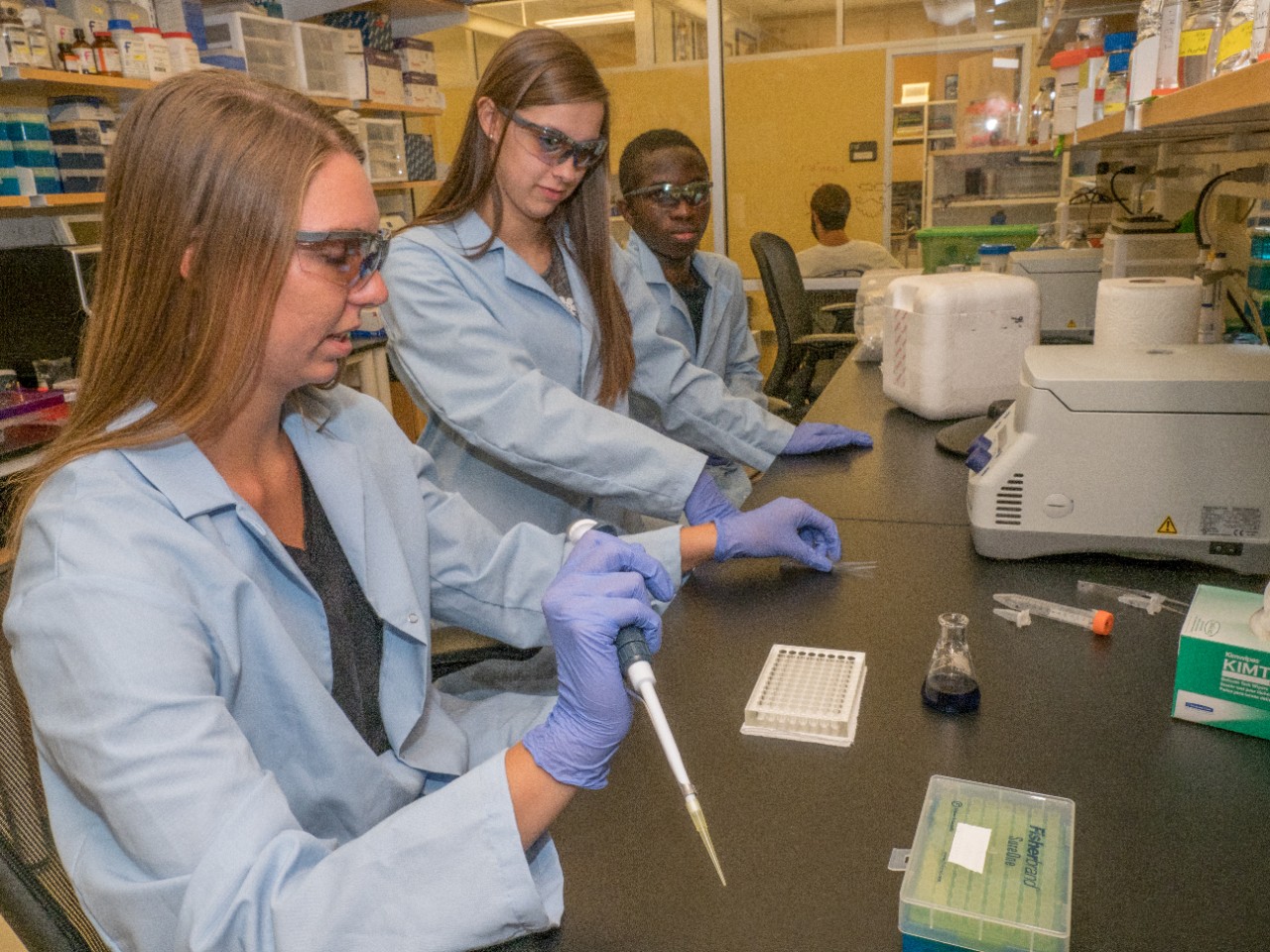
UC’s living laboratory offers hands-on instruction
UC hosts Discovery Day at Center for Field Studies
Students crowded around picnic tables in the shade of a historic barn to get a close look at dozens of stuffed birds.
There was an orange Baltimore oriole and a red northern cardinal, a speckled starling and a spotted brown thrasher.
The University of Cincinnati students spent the morning looking for birds with binoculars in the woods around the center where they and biology Professor Ronald Canterbury counted more than 30 species, which is not bad for a hot summer day in Ohio.
Students are taking a summer ornithology course in an open-air classroom at UC’s Center for Field Studies, a former farm surrounded by woods, prairies and wetlands. Here students get a chance to work on research projects and take classes surrounded by nature.
“It’s a phenomenal place. I would love to spend every day here,” Canterbury said. “There aren’t many urban research universities that have a field station. It offers great opportunities for students and researchers.”

UC will host Discovery Day on from 10 a.m. to 2 p.m. Aug. 3 with children's activities including creek walks, nature talks and demonstrations. Photo/UC
Discovery Day
UC will open the center to the public on Aug. 3 with children’s activities, tours and talks as part of its Discovery Day from 10 a.m. to 2 p.m. Children can take a creek walk and learn about spiders, insects, birds, fossils and fish. There will be a bird-banding demonstration from 9 to 11 a.m. and aquarium displays of native Ohio fish.
Center Director Ken Petren, a professor of biology and former dean of UC’s College of Arts and Sciences, said the field station plays host to a diverse group of departments, from anthropology to geology to biology to journalism.
“It’s so valuable for the students to have a class in nature,” Petren said. “During COVID, we were busting at the seams with students who wanted to take classes here.”
UC leases the former Shaker farm from Great Parks of Hamilton County.
At the center, UC biologists and their students conduct research on tick-borne illness, monarch butterfly migration and jumping spider vision. Across the street, students in UC’s College of Design, Architecture, Art, and Planning planted hops for a class.
I’ve been looking forward to this all week. I think it’s a great place for classes.
Holly Erickson, Visiting student at UC's Center for Field Studies
Likewise, his biology students planted a “tiny forest,” a small plot of two dozen shrubs and flowering plants that they surrounded with deer fencing.
“You condense an area with high biodiversity to serve as an island in an urban setting,” he said. “You choose plants that will mature quickly and provide shade and rapidly generate flowers for pollinators and fruit. We have persimmon and 22 other species. It’s doing great.”
Besides ready access to Miami Whitewater Forest, the center is in the vicinity of UC’s groundwater monitoring project along the Great Miami River and a former uranium processing plant where UC environmental health officials have worked on health surveillance for neighbors.
“I realized that for the college and university to value the field center, it has to be used a lot more than it was,” Petren said. “So I really tried to open the doors and welcome other departments.”

Visiting student Naomi Moore releases a house wren she banded at UC's Center for Field Studies. Photo/Andrew Higley/UC Marketing + Brand
Opening the doors
Petren is also reaching out to public and community groups.
The Urban Appalachian Community Coalition hosts writing and arts retreats at the center.
“What I’m trying to do is create a relationship with Great Parks of Hamilton County and Cincinnati Parks and the Mill Creek Alliance, which is restoring the Mill Creek. I’m trying to find ways to help them achieve their goals,” he said. “Groups of students work with community partners to help assess their restorations.”
One example is the push to remove non native honeysuckle. Petren said conservation groups realize they have to plant native species in place of the honeysuckle or it will simply return.
“But planting vast areas in a natural setting is different from planting in your garden where you’re babying it,” he said. “They can’t plant big trees because it’s too costly, so they put seedlings in and hope they survive.”
His students are helping the groups determine if the native species are taking hold.

UC Professor Ken Petren, director of UC's Center for Field Studies, examines a "tiny forest" students planted with native shrubs and trees. Surrounded by deer fencing, the tiny forest is designed to grow quickly to provide resources for pollinators and other wildlife. Photo/Michael Miller
Petren spent much of his career studying the famous finches of the Galapagos Islands that Charles Darwin used to develop the theory of evolution. More recently, he has turned his attention to crafting innovative new ways to study the seasonal succession of flowering plants across large prairies like the ones at the center.
“I’m learning to fly a drone to do aerial surveys,” he said.
The drone uses a camera and AI software that can identify and map flowers and plants from the air. Many prairie plants flower at different times of year. By taking high-resolution images from the air at different times of year, Petren hopes to improve the software’s ability to identify and map flowers in fine enough detail to be useful to biologists for statistical analysis.
Typical botanical ground surveys can be tedious and time consuming, he said. But by using drones, they can capture useful data to track the health and diversity of the prairies.

UC students examine taxidermied birds as part of an ornithology class led by UC biology Professor Ronald Canterbury. Photo/Michael Miller
Open-air classrooms
Students said they like coming to the center for classes.
Holly Erickson, a forestry, fisheries and wildlife student at Ohio State University, spent a summer day at the center to get more bird-banding experience from Canterbury. Erickson said she hopes one day to teach at a field center like UC’s.
“I’ve been looking forward to this all week. I think it’s a great place for classes,” she said. “I like the habitat diversity here. It has the prairie and forest.”
After graduating, she plans to work as a field technician. But those jobs often require previous hands-on experience.
“They want to know how much experience and training you have. How many birds have you banded? And you can’t get that in a classroom,” she said. “This is a really important place to get experience for future careers.”
Featured image at top: Students take classes in an open-air classroom at UC's Center for Field Studies. Photo/Andrew Higley/UC Marketing + Brand
Discovery Day at UC Center for Field Studies
UC’s College of Arts and Sciences and the UC Alumni Association will play host to Discovery Day from 10 a.m. to 2 p.m. Saturday, Aug. 3, featuring guided tours, creek walks and talks about insects, animals and plants. The event is free and open to the public.
Activities include:
- Bird banding demonstration (9 to 11 a.m.)
- Prairie restoration and flower walk.
- Stream walk.
- Pollinators, spiders and insect roundup.
- Mindfulness and nature psychology.
- Fossil hunting in Cincinnati.
- Green infrastructures.
- Great Parks stream erosion table.
- Native fish aquarium displays.
- Tiny forest and rain garden tour.
- Invasive species identification and removal and native species tips.

UC's Center for Field Studies is a former Shaker farm in Crosby Township. Photo/UC

UC biology Professor Ronald Canterbury collects his mist nets after a morning of banding birds at UC's Center for Field Studies. Photo/Andrew Higley/UC Marketing + Brand

Visiting student Holly Erickson removes a yellow-breasted chat from a mist net while banding birds at UC's Center for Field Studies. Photo/Andrew Higley/UC Marketing + Brand

Visiting student Naomi Moore prepares to release a common yellowthroat she banded at UC's Center for Field Studies. Phoot/Andrew Higley/UC Marketing + Brand

UC's Center for Field Studies is a former Shaker farm that UC leases from Great Parks of Hamilton County for classrooms and research. Photo/Andrew Higley/UC Marketing + Brand

Biology students learn to conduct a botanical survey in the tallgrass prairies of UC' Center for Field Studies. Photo/Ravenna Rutledge/UC Marketing + Brand

UC biology students learn to identify plant species while conducting a botanical survey at UC's Center for Field Studies. Photo/Ravenna Rutledge/UC Marketing + Brand

UC students conduct biology research at UC's Center for Field Studies. Photo/Jay Yocis/UC

UC students combine fieldwork at UC's Center for Field Studies with research in a biology lab. Photo/Jay Yocis/UC

UC's Center for Field Studies will host a public open house called Discovery Day on Aug. 3 from 10 a.m. to 2 p.m. Photo/Andrew Higley/UC Marketing + Brand
Next Lives Here
The University of Cincinnati is classified as a Research 1 institution by the Carnegie Commission and is ranked in the National Science Foundation's Top-35 public research universities. UC's graduate students and faculty investigate problems and innovate solutions with real-world impact. Next Lives Here.
Related Stories
UC launches pioneering study of 'forever chemicals' in drinking water
May 2, 2024
UC is launching a new investigation to examine excess nutrients and contaminants in groundwater that provides drinking water for 2 million Ohioans.
UC alum is a Queen City Pollinator
June 29, 2022
UC Alumni Sylvana Ross is saving bees and headed to Cornell University under fellowship where she will start her PhD program in entomology. She is a co-founder of the Queen City Pollinators Project.
Blind cavefish have extraordinary taste buds
August 15, 2024
UC biologist Josh Gross studies blind cavefish, a species of fish that dwell in cave ponds in Mexico. In a study, supported by the National Science Foundation, Gross looked at the timeline for when the cavefish develop additional taste buds on the head and chin, finding the taste bud expansion starts at five months and continues into adulthood.
